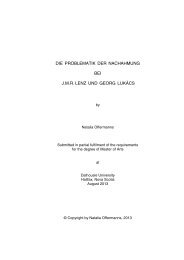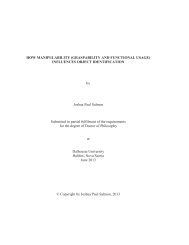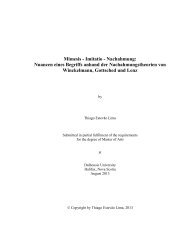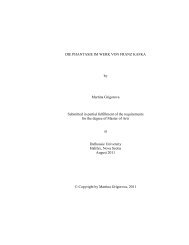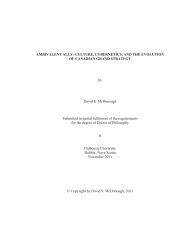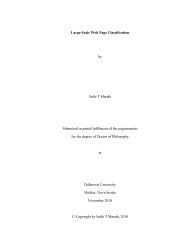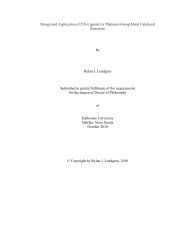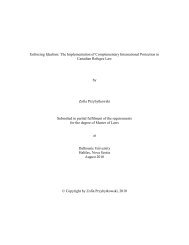ADAPTING TRISTRAM SHANDY by Adria Young Submitted in ...
ADAPTING TRISTRAM SHANDY by Adria Young Submitted in ...
ADAPTING TRISTRAM SHANDY by Adria Young Submitted in ...
Create successful ePaper yourself
Turn your PDF publications into a flip-book with our unique Google optimized e-Paper software.
(We<strong>in</strong>er 17). Critics began to value the <strong>in</strong>termediality and <strong>in</strong>teractivity of comics <strong>by</strong><br />
understand<strong>in</strong>g how comics work, and how comic adaptations can renew the orig<strong>in</strong>al text<br />
through <strong>in</strong>terpretation and creation. With the mandate to “support experiments us<strong>in</strong>g the<br />
comic book format” (We<strong>in</strong>er 47), Tundra Publish<strong>in</strong>g released Scott McCloud’s<br />
Understand<strong>in</strong>g Comics: The Invisible Art <strong>in</strong> 1993, which features a cartoon McCloud<br />
exegetically mov<strong>in</strong>g through panels of illustrated comic book theory. Joyce Gogg<strong>in</strong><br />
observes that McCloud “venture[s] his own theory of comics” (11) with arguments that,<br />
while contested <strong>by</strong> scholars and critics, cont<strong>in</strong>ue to supply the term<strong>in</strong>ology for critical<br />
discussion.<br />
Understand<strong>in</strong>g Comics is a comic book about comic books. McCloud first def<strong>in</strong>es<br />
“comics” as “juxtaposed pictorial and other images <strong>in</strong> deliberate sequence, <strong>in</strong>tended to<br />
convey <strong>in</strong>formation and/or produce an aesthetic response <strong>in</strong> the viewer” (McCloud 9).<br />
This dist<strong>in</strong>ction, “deliberate sequence,” is an important one; Rowson illustrates Tristram<br />
Shandy out of sequence. In place of Sterne’s narrative digressions, Rowson uses visual<br />
digressions: the panels are crowded, non-uniform, and filled with visual icons that<br />
represent elements of the text.Sequence is a major feature and convention of graphic<br />
novels, but Rowson challenges the construction of the visual text; <strong>in</strong> one panel, we are <strong>in</strong><br />
the bowl<strong>in</strong>g green, for example, and <strong>in</strong> another we are <strong>in</strong> a void. As <strong>in</strong> Tristram Shandy,<br />
the notion of sequence is mocked; Rowson uses illustrated signposts throughout the<br />
panels that ‘direct’ the reader’s sense of narrative direction. These signposts, however,<br />
marked, “Ye Olde Narrative,” po<strong>in</strong>t <strong>in</strong> the wrong direction or to nowhere at all. 52 At<br />
times, too, the words “narrative” scroll around frames. And, while the history of visual art<br />
and visual narrative ranges from classical frescoes to illum<strong>in</strong>ated manuscripts, the visual<br />
37



